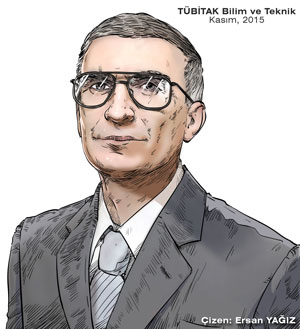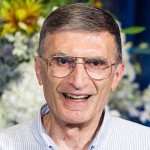The cells’ toolbox for DNA repair
 The Nobel Prize in Chemistry 2015 is awarded to Tomas Lindahl, Paul Modrich and Aziz Sancar for having mapped, at a molecular level, how cells repair damaged DNA and safeguard the genetic information. Their work has provided fundamental knowledge of how a living cell functions and is, for instance, used for the development of new cancer treatments.
The Nobel Prize in Chemistry 2015 is awarded to Tomas Lindahl, Paul Modrich and Aziz Sancar for having mapped, at a molecular level, how cells repair damaged DNA and safeguard the genetic information. Their work has provided fundamental knowledge of how a living cell functions and is, for instance, used for the development of new cancer treatments.
Each day our DNA is damaged by UV radiation, free radicals and other carcinogenic substances, but even without such external attacks, a DNA molecule is inherently unstable. Thousands of spontaneous changes to a cell’s genome occur on a daily basis. Furthermore, defects can also arise when DNA is copied during cell division, a process that occurs several million times every day in the human body.
The reason our genetic material does not disintegrate into complete chemical chaos is that a host of molecular systems continuously monitor and repair DNA. The Nobel Prize in Chemistry 2015 awards three pioneering scientists who have mapped how several of these repair systems function at a detailed molecular level.
In the early 1970s, scientists believed that DNA was an extremely stable molecule, but Tomas Lindahl demonstrated that DNA decays at a rate that ought to have made the development of life on Earth impossible. This insight led him to discover a molecular machinery, base excision repair, which constantly counteracts the collapse of our DNA.
 Aziz Sancar has mapped nucleotide excision repair, the mechanism that cells use to repair UV damage to DNA. People born with defects in this repair system will develop skin cancer if they are exposed to sunlight. The cell also utilises nucleotide excision repair to correct defects caused by mutagenic substances, among other things.
Aziz Sancar has mapped nucleotide excision repair, the mechanism that cells use to repair UV damage to DNA. People born with defects in this repair system will develop skin cancer if they are exposed to sunlight. The cell also utilises nucleotide excision repair to correct defects caused by mutagenic substances, among other things.
Paul Modrich has demonstrated how the cell corrects errors that occur when DNA is replicated during cell division. This mechanism, mismatch repair, reduces the error frequency during DNA replication by about a thousandfold. Congenital defects in mismatch repair are known, for example, to cause a hereditary variant of colon cancer.
The Nobel Laureates in Chemistry 2015 have provided fundamental insights into how cells function, knowledge that can be used, for instance, in the development of new cancer treatments.
Aziz Sancar, U.S. and Turkish citizen. Born 1946 in Savur, Turkey. Ph.D. 1977 from University of Texas, Dallas, TX, USA. Sarah Graham Kenan Professor of Biochemistry and Biophysics, University of North Carolina School of Medicine, Chapel Hill, NC, USA.
http://www.med.unc.edu/biochem/people/faculty/primary/asancar
Biochemistry preferable to life as a doctor
Aziz Sancar’s fascination with life’s molecules developed while he was studying for a medical degree in Istanbul. After graduating, he worked for a few years as phycisian in the Turkish countryside, but in 1973 he decided to study biochemistry. His interest was piqued by one phenomenon in particular: when bacteria are exposed to deadly doses of UV radiation, they can suddenly recover if they are illuminated with visible blue light. Sancar was curious about this almost magical effect; how did it function chemically?
Claud Rupert, an American, had studied this phenomenon and Aziz Sancar joined his laboratory at the University of Texas in Dallas, USA. In 1976, using that time’s blunt tools for molecular biology, he succeeded in cloning the gene for the enzyme that repairs UV-damaged DNA, photolyase, and also in getting bacteria to over-produce the enzyme. This work became a doctoral dissertation, but people were hardly impressed; three applications for postdoc positions resulted in as many rejections. His studies of photolyase had to be shelved. In order to continue working on DNA repair, Aziz Sancar took up a position as laboratory technician at the Yale University School of Medicine, a leading institution in the field. Here he started the work that would eventually result in the Nobel Prize in Chemistry.
Aziz Sancar – investigating how cells repair UV damage
By then it was clear that bacteria have two systems for repairing UV damage: in addition to light-dependent photolyase, a second system that functions in the dark had been discovered. Aziz Sancar’s new colleagues at Yale had studied this dark system since the mid-1960s, using three UV-sensitive strains of bacteria that carried three different genetic mutations: uvrA, uvrB and uvrC.
As in his previous studies of photolyase, Sancar began investigating the molecular machinery of the dark system. Within a few years he had managed to identify, isolate and characterise the enzymes coded by the genes uvrA, uvrB and uvrC. In ground-breaking in vitro experiments he showed that these enzymes can identify a UV-damage, then making two incisions in the DNA strand, one on each side of the damaged part. A fragment of 12-13 nucleotides, including the injury, is then removed.
Similar mechanisms for UV damage repair in humans and bacteria
Aziz Sancar’s ability to generate knowledge about the molecular details of the process changed the entire research field. He published his findings in 1983. His achievements led to an offer of an associate professorship in biochemistry at the University of North Carolina at Chapel Hill. There, and with the same precision, he mapped the next stages of nucleotide excision repair. In parallel with other research- ers, including Tomas Lindahl, Sancar investigated nucleotide excision repair in humans. The molecular machinery that excises UV damage from human DNA is more complex than its bacterial counterpart but, in chemical terms, nucleotide excision repair functions similarly in all organisms.
So, what happened to Sancar’s initial interest in photolyase? Well, he eventually returned to this enzyme, uncovering the mechanism responsible for reviving the bacteria. In addition, he helped to demonstrate that a human equivalent to photolyase helps us set the circadian clock.

